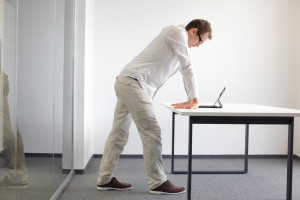(Originally published on Delivering Happiness)
 We often think of happiness as a state of mind, but our physical bodies have a large impact on our well-being that goes beyond our physical health. Our bodies can either help or hinder our performance and well-being, on the job or at home, in more ways than are readily obvious.
We often think of happiness as a state of mind, but our physical bodies have a large impact on our well-being that goes beyond our physical health. Our bodies can either help or hinder our performance and well-being, on the job or at home, in more ways than are readily obvious.
Our well-being is tied to our bodies in more ways than one. Our physical fitness can affect our moods, our energy levels, and our mental performance. Consider the following:
- Research has shown that just 15 minutes of exercise a day can help increase energy levels. According to the American Council on Exercise, if a sedentary individual begins an exercise program it will enhance the blood flow carrying oxygen and nutrients to muscle tissue improving their ability to produce more energy [the chemical adenosine triphosphate].
- Physical activity can help improve cognitive processes, such as planning and scheduling. This is due to our brain’s deployment of “miracle grow for the brain” [clinically referred to as BDNF, brain-derived neurotrophic factor], which has been shown to improve the function of neurons and encourage new neurons to grow.
- Exercise can help reduce stress. When we exercise, our brain activity causes a molecular by-product, and much like the breakdown and repair of our muscles when we lift weights, our brains have a subsequent repair mechanism that strengthens cells.
- Exercise can help prevent depression. According to Henriette van Praag, a neuroscientist at the National Institutes of Health, exercise is just as effective as medication at helping prevent depression.
What does this have to do with workplace culture? In the United States, employed adults spend about half of their waking hours at work. Research has shown there is more to the 3-5 workouts/week exercise equation than traditionally prescribed. While these workouts can help can build cardiovascular health, build muscle, and increase flexibility, this is not the whole equation. Recent studies tell us that sitting is the new smoking. Take note: too much sitting is something altogether different from too little exercise. Too much sitting can be very damaging to our health, quite possibly compromising our metabolic health.
Now consider the typical office environment where members of our team might stare transfixed for hours upon hours, propped in front of a screen. While any one of us might be a gym rat, a runner or a yoga guru, if we are sitting the rest of those non-gym hours, we might be suffering from what has been coined the active couch potato syndrome. We might be working hard at our exercise regime, only to potentially later compromise our health with extended sitting. Many medical professionals are now warning that given the choice between merely interrupting sitting or doing the traditional idea of a workout, the interruption of inactivity may be more important for achieving health benefits. Merely standing up will activate big muscles in our bodies and trigger a series of physiological reactions. And we can trigger even bigger effects by moving.
It’s time to make a culture shift in workplaces to one of increased movement. Leaders can take an active role in finding ways to bring movement into your workplace. Individuals can look for opportunities to incorporate more movement into their everyday work routines. And perhaps you can influence a few coworkers along the way to join you since habits can be contagious in the workplace. Nicholas Christakis and James Fowler’s research has shown that behaviors [such as quitting smoking or exercising] can pass through our networks of people as if they are contagious viruses, affecting our health and habits.
Not sure how to start? Here are a few suggestions for increasing a culture of movement in the workplace:
- Just do it! You can start by modeling the movement you want to see.
- Encourage standing. You can share information with your workplace team, inspiring just the consciousness of disrupting extended sitting. Or even better, encourage employees to take more walks to the coffee machine or deliver a message on foot instead of by email.
- Have a walking meeting. When there are two or three participants of a meeting, a walking meeting can be effective and invigorating. Be forewarned though, with more participants, it can become difficult to hear everyone.
- Encourage short bursts of exercise. If you are so inclined, and your work environment and culture allow it, you can take it a step further and intermittently try more vigorous movement – maybe a few lunges or jumping jacks. That can both move your physical health in the right direction and increase alertness.
So, at a minimum, stand up! And if you can, get your coworkers to stand up with you. Just stand up two to three times per hour. And if you can, add some movement. You might just find that while you reduce the risk for the metabolic diseases associated with inactivity [such as heart disease and diabetes], you may find you and your coworkers feel a little smarter, moods a bit lighter, and a few more light bulb moments!
References
Christakis, N. A., & Fowler, J. H. (2007). The spread of obesity in a social network-Reply. New England Journal of Medicine, 357(18), 1867-1868.
Ratey, J.J & Manning, R. (2014). Go Wild: Free Your Body and Mind from the Afflictions of Civilization. New York: Little, Brown and Company.
Ratey, J. J. & Loehr, J.E. (2011). The positive impact of physical activity on cognition during adulthood: a review of underlying mechanisms, evidence and recommendations, Reviews in the Neurosciences, 22(2), 171–185
van Praag, H. (2009). Exercise and the brain: something to chew on. Trends in neurosciences, 32(5), 283-290.
